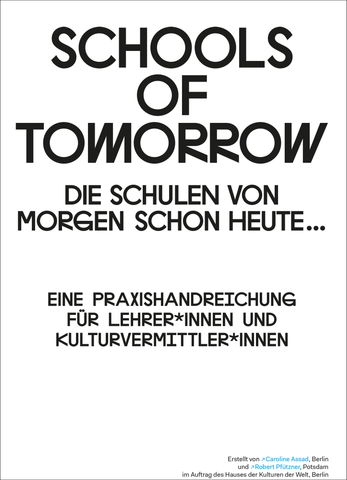10 Action Recommendations
Practical aids for teachers and cultural mediators
What can really be done differently in schools? What did the students, teachers and artists experience during the Schools of Tomorrow process and how can others profit from their knowledge? How can what they experienced be turned into action?
The educational theorists Caroline Assad and Robert Pfützner asked participating students, artists and educators from what learning experiments they envision potentials for the evolution of future learning. They used these observations, interviews and conversations to draw up the following Action Recommendations. The chief aim is to promote the aesthetic and political empowerment of children and teenagers in school life, to strengthen critical reflection and participation in school life, and to include digitality and environmental friendliness in school practice.
See the detailed Action Recommendations for teachers and cultural mediators [in German, PDF, ca. 200 KB]
Attitudes of “learning-teaching” stakeholders
- Failure as an opportunity and reason for learning
- Boredom and tolerating non-productivity
- Learning as a physical act
- Exercising the authority of art and of things
- Transferring and shouldering responsibility
The establishment of a learning community
- Making students teachers
- Thinking over long spans of time
- Visualizing the knowledge of all
- Getting the team and school administration on board
- Inscribing other learning in the curriculum
Participation and responsibility
- Implementing one’s own ideas
- Independence creates confidence
- The school as a whole has to stand behind the projects
Sustainability and innovation
- Get out of the classroom!
- Learning with students from other classes
- Individual study times
- Life world orientation
- “Free periods” or “free study periods”
- “Self-learning modules”
Needs-oriented interior design
- Participatory interior design
- Room design with light
- Comfort
- Co-opting rooms
- spatial acoustics and volume: Defining on-off zones and time rhythms
- Multifunctional mobile furniture
- Using outdoor spaces
Everyday life and rhythm
- Providing places to rest and retreat
- Paying attention to biological and social rhythms
- Healthy nutrition and peer cooking
Freedom, emancipation and structure
Digitality and real life
- Use of cell phones in class
- Free WiFi in schools
- Learning from the students
- Using potentials of social media
- Virtual reality and analog spaces
The school surroundings
- The public!
- Working and producing professionally
- Not cramming theory, but learning mimetically
- Urban design by students
Resources
- Open source
- Open Educational Resources (OER)
- Multiple uses and conversion of existing spaces and materials
- Funding and booster clubs
